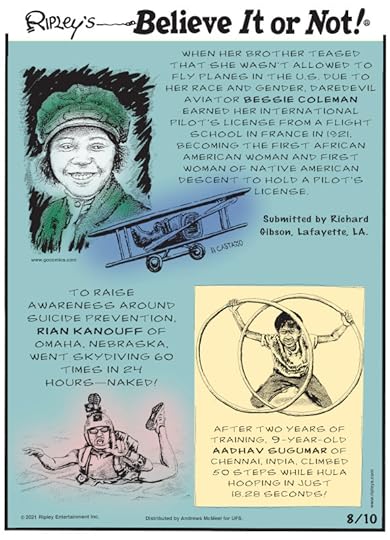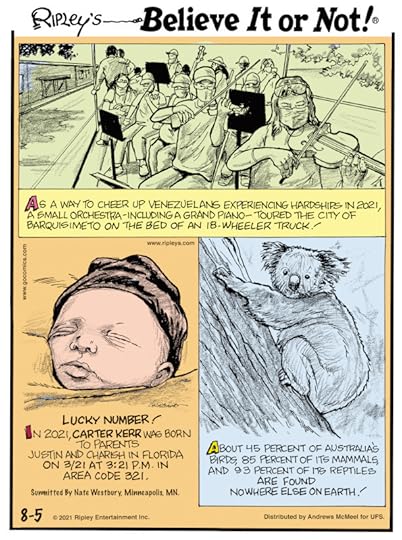Ripley Entertainment Inc.'s Blog, page 132
August 10, 2021
Nickelodeon Favorites Turn 30: Origins Of Iconic Nicktoons
Featured in Ripley's Believe It or Not!

Nothing hits a 90s kid right in the nostalgia like a good Nickelodeon throwback. And, honestly, is there anything more quintessentially 90s than spending a sick day binge-watching your favorite Nickelodeon shows?
Before there were streaming services, DVRs, DVDs, or even Disney Channel as a basic cable offering, Nickelodeon ruled the kids’ television roost. Often referred to as the network’s heyday, Nickelodeon’s groundbreaking 1990s programming gave kids the chance to tune into shows created just for them. In a time when cartoons typically served as a marketing tool for toys that already existed, Nickelodeon broke the mold with original programming focusing on what it feels like to be a kid.
While we could wax poetic about the live-action shows of Nickelodeon’s past, nothing is more iconic than a Nicktoon. From Hey Arnold! to Angry Beavers and Aaahh!!! Real Monsters, these uniquely weird cartoons defined a generation of wild and crazy kids.
Of course, none of these classic Nicktoons would have existed if it hadn’t been for the success of the original three—the holy toon trinity, if you will: The Ren & Stimpy Show, Doug, and Rugrats, which all premiered August 11, 1991. Yep, 30 years ago!
In celebration of these Pearl anniversaries, we’re sharing some strange and shocking facts behind the sketches of your favorite Nicktoons.
Who Runs the Shows? Girls!When you think about female powerhouses that came out of Nickelodeon, Charlotte Pickles may come to mind. But, Angelica’s girl boss mom wouldn’t have even existed without a host of strong women literally running the show at Nickelodeon’s network headquarters.
Geraldine Laybourne was president of Nickelodeon from 1984–96 and is largely responsible for turning the lowest-rated cable network into the top dog. Laybourne certainly greenlit many of the shows we know and love, but there was one original Nicktoon in particular, she definitely did not believe was a good fit for children’s programming—The Ren and Stimpy Show.
Ren & Stimpy: A Kids’ Toon with Parental WarningsConsidering The Ren & Stimpy Show’s adult themes and lewd metaphors, it shouldn’t be too surprising that Laybourne felt the show was better suited for Nickelodeon’s then-struggling sister network, MTV.
The creative differences between Ren & Stimpy’s creator, John Kricfalusi, and the network came to a head during the second season, resulting in Kricfalusi’s dismissal.
View this post on Instagram
A post shared by NickRewind (@nickrewind)
At the very least, the show typically aired at odd hours where younger kids were unlikely to see the often physically abusive or sexual content and went on for five seasons before being canceled.
After leaving Nickelodeon, Kricfalusi took his party to Spike TV with Ren & Stimpy: Adult Party Cartoon. While the show was notorious for pushing the envelope as a kids’ show, keeping it as a kids’ show may have been its appeal. Adult Party Cartoon was canned after three episodes due to its aggressively lewd humor. We’ve got two words for you: log sawing.
The Simpsons ConnectionLooking back at early Nicktoons, there are noticeable similarities between the children-focused programs and more adult programming like The Simpsons—and for a good reason! The husband and wife duo of Arlene Klasky and Gábor Csupó was responsible for early renderings of Bart, Marge, Lisa, Homer, and the rest of the gang. They even gave the family their signature yellow skin tone! Their stint at The Simpsons didn’t last too long, as they were fired for creative differences and moved over to Nickelodeon to create Rugrats.
Nicktoons’ connections to The Simpsons didn’t end with Klasky Csupó, however. Hey, Arnold! was created by Craig Bartlett, the husband of Lisa Bartlett. Lisa Bartlett is the sister of Matt Groening, A.K.A. the creator of The Simpsons. Lisa was a huge part of her husband’s Hey, Arnold! success and can be credited for Helga Pataki’s secret obsession with Arnold in the show—secret closet shrine and all!
But Lisa’s brother, Matt Groening didn’t mince words when talking about the new toons on the block, praising The Ren and Stimpy Show as “the funniest cartoon on T.V.” and the “only good cartoon” besides his own.
Rugrats: A Cultural PhenomenonThough Klasky and Csupó eventually divorced, it’s lucky for millennials that they ended things amicably and continued to work together. The pair’s animation studio, Klasky-Csupó, is responsible for a ton of iconic Nicktoons such as As Told By Ginger, The Wild Thornberrys, Rocket Power, and Aaahh!!! Real Monsters!
Klasky and Csupó probably didn’t dwell too much on their former boss’s opinions since they had their own hit on their hands! Over its nine-season run, Rugrats became a cultural phenomenon. The characters even have a star on the Hollywood Walk of Fame!
The concept behind the show was simple. Klasky was on maternity leave when she had the passing thought, “What if babies could talk?” So, naturally, she started doodling, and out came the weird-looking Rugrats we all know and love.
Embed from Getty Imageswindow.gie=window.gie||function(c){(gie.q=gie.q||[]).push(c)};gie(function(){gie.widgets.load({id:'UnIzcJKSSXd2UvhY39kjCA',sig:'pmMTM5M9AgC378KtCEeh1zwsil7HYUcdQ2BgJ1Clu6U=',w:'414px',h:'594px',items:'1327542',caption: true ,tld:'com',is360: false })});At its core, Rugrats was a show about friendship, with each personality serving a purpose. Chuckie was anxious, Phil and Lil were the peanut gallery with a spot-on sibling dynamic, Angelica was a rarely-shown female bully, and Tommy was their fearless leader.Screwdriver in diaper, Tommy Pickles was ready to take on the world! Being the bravest baby out there didn’t come easy, though, as creators revealed he gained his courage from fighting for his life in an incubator after he was born prematurely.
Anti-Defamation League Was Not A FanThough Rugrats was often lauded for its portrayal of a Jewish family in America, the Anti-Defamation League took issue with two of the show’s characters—Boris and Minka, Didi’s immigrant parents.
Tommy’s grandparents rarely came to town during the show’s tenure, with their most iconic features revolving around Passover and Hanukkah. That being said, they were shown even less frequently after the Anti-Defamation League sued Nickelodeon for featuring offensive Jewish stereotypes with the characters in 1998.
The League specifically felt that the cartoon’s corresponding newspaper comic depicted Boris as a caricature of a Jewish person, with a big nose and large ears that resembled depictions used in Nazi Propaganda.
From the Playpen to the Big ScreenEven in the midst of the lawsuit, Rugrats continued to thrive and became the first Nicktoon to grace the big screen. The Rugrats Movie opened in theaters in 1998, making over $140 million worldwide. It also introduced the little brother you love or hate: Dill Pickles.
The venture proved that Nickelodeon could contend with Disney’s animation studios in the motion picture sector and even got Rugrats two sequels! The combined box office pull for the trilogy made Rugrats the 25th highest-grossing animated film series ever.
While other Nicktoons were turned into movies, it’s worth noting that Doug’s 1st Movie was created after the cartoon was sold to Disney—you know, when Patti cut her hair and Doug got longer sleeves.
Beautify BluffingtonThat brings us to the town of Bluffington, where Doug Funnie is just an average kid trying to fit in and get his crush to notice him.
Created by Jim Jinkins, Doug seemed like the less-weird toon in the original Nicktoon lineup. That is until he starts imagining himself as a bird-themed superhero.
View this post on Instagram
A post shared by NickRewind (@nickrewind)
It’s hard to imagine Doug with any other name, but Jinkins originally named the character Brian. It was changed because Brian sounded “too fancy” for a kid who was supposed to be average.
Doug was filled with colorful characters with personalities to match. From Skeeter’s blue hue to Roger’s slime green skin tone, the rainbow coloring of the characters represented an ambiguous racial makeup created by Jinkins as a way to break through Nickelodeon’s “whiteness.”
According to former Nick staff members, the network execs were fully aware of their lack of diversity in programming at the time, intentionally keeping it that way because it suited their finances.
Fortunately, Jinkins’ plan worked out, and Nickelodeon made great strides in diversity a few years later with the cast of All That.
In a more entertaining financial commentary, Doug’s tech-happy neighbors, the Dinks, were named for the phrase “Double Income, No Kids.”
Nicktoons, A LegacyThese three Nicktoons are often referred to as the backbone of Nickelodeon’s brand, but they can also be credited with reinvigorating an entire genre. While they weren’t the first cartoons on the network, these original programs changed the game for Nickelodeon and other channels alike. Creative, comical, and downright weird, The Ren & Stimpy Show, Rugrats, and Doug inspired an entire generation to think out of the box, permitting kids to be exactly who they were. To that, we say, “Cheers to 30 years!”
By Meghan Yani, contributor for Ripleys.com
EXPLORE THE ODD IN PERSON! Discover hundreds of strange and unusual artifacts and get hands-on with unbelievable interactives when you visit a Ripley’s Odditorium!Source: Nickelodeon Favorites Turn 30: Origins Of Iconic Nicktoons
CARTOON 08-10-2021
August 9, 2021
CARTOON 08-09-2021
August 8, 2021
CARTOON 08-08-2021
August 7, 2021
CARTOON 08-07-2021
August 6, 2021
Who In The World Is Carmen Sandiego?
Featured in Ripley's Believe It or Not!

Welcome world travelers! Years ago, computer gamers spent hours traveling the globe, subconsciously learning geography and valuable research skills without even realizing it. The mission at hand? To find out Where in the World Is Carmen Sandiego? Dial up that Internet, because we’re taking it back to the coolest video game on the map and the iconic lady in red who kept the world guessing.
Tracking Down The ThiefA fictional character, Carmen Sandiego was the globe-trotting, mystery-making main character of a hit 1980s computer game. One of the first of its kind, Where in the World Is Carmen Sandiego? was a game originally created to be a simple graphics-based adventure geared towards kids.
The programmer behind this new virtual world, Dane Bigham of Brøderbund Software, was hoping to put his own spin on the cause-and-effect adventure games kids were used to—he wanted to give players a clear objective: track down the thief. And in the original plans for the game, there were quite a few thieves to find! Originally, Ms. Sandiego was just one of the many villains to be featured in the game, but she would soon make a name for herself as a titular character.
Carmen Sandiego And The World Almanac and Book of FactsIt wasn’t in the original blueprints to make the game educational, but Bigham’s boss, Gary Carlston, wanted to test out a totally new concept. By combining his personal fascination with traveling in the physical world and the general public’s obsession with the virtual one, the two decided on quite an unconventional idea: with each sale of their new game, they included a physical copy of The World Almanac and Book of Facts.
Though they didn’t like using the word “educational” in any form of marketing for this new game, the addition of the Almanac, paired with the visually stimulating graphics and minimal on-screen text clues, gave kids a subconscious lesson as they played. At this time, most video games were in the text-heavy, choose-your-own-adventure style (have you seen the ’90s version of Ripley’s popular game, The Riddle of Master Lu?) Kids were used to reading clues, and clicking away on the hunt for a person, object, or missing artifact.

Image credit: voxeros via Flickr (CC BY-NC 2.0)
Where In North Dakota Is Carmen Sandiego?Anyone lucky enough to be a part of Carmen’s generation knows that she was certainly a tricky thief to catch! In her original pixelated form, Carmen Sandiego was the culprit for the grand theft of many expensive pieces, from landmarks to artwork. And it was the player’s job, as a member of the police force, to catch her. Sounds like such a basic concept, but clearly, it worked. After Where in the World Is Carmen Sandiego? we got Where in the U.S.A., Where in Europe, Where in Time, and then it got really specific, like Where in North Dakota…?
Bigham left the small empire Carmen had built shortly after these sequels took off. While it wasn’t his intention to continue creating more places for Sandiego to go, the generation of gamers wanted more Carmen. And, to this day, she’s still alive and well!
From The PC To The TVAfter the many spinoffs surrounding the sassy lady in red and her team of henchmen (a.k.a. the Villain’s International League of Evil), the folks at Brøderbund decided it was time for Carmen to move from our PCs to our TVs. The PBS television program, also named Where in the World is Carmen Sandiego?, was a game show based around the same premise as Carmen’s video games. Throughout the 296-episode run, the main geographical components and facts featured in the game were repurposed as contestants, or “detectives,” put their knowledge to the test. Plus, it had a clever theme song to go along with it!
Once Where in the World dissolved, there were a few attempts to bring back iterations of the show, but all good things must come to an end—the spark had faded. Now, after an animated series, a game show, many video game variations, and talk of a live-action film, Carmen Sandiego graces the screen again in her own Netflix animated series. Though she started as a thief and antagonist back in her 1985 debut, present-day Carmen has made quite a personality change. She headlines the series as a master thief who uses her skills for good: foiling the evil plans of her old V.I.L.E. stomping grounds.
View this post on Instagram
A post shared by The Official Carmen Sandiego (@theofficialcarmensandiego)
The mere idea of this scarlet-hat thief and her accolades across the globe started a whole Where in the World movement. But, one question still lingering in the mind of adults today is not where in the world is Carmen Sandiego, but rather, who in the world is she?
Who In The World Is Carmen Sandiego?The Where In The World video game manual gives a snippet of background for the mysterious woman—a former spy for the Intelligence Service of Monaco. But beyond that, we’re left in the dark in terms of this fierce female character. Believe It or Not!, Carmen’s name was decided by one of the original Brøderbund scriptwriters for the 1985 game. David Siefkin, the man behind the iconic name, said, “In my draft, she was only one of several villains. I wanted an exotic name and took it from the singer, Carmen Miranda.” From there he explained, “The design team brought her to life. I invented the name, but the design team really created the personality of Carmen.”
It wasn’t until the 1994 animated series, after years of establishing Carmen as a mysterious character, that show writers started to give her a bit more of a narrative. Her animated presence in the cartoon series, Where on Earth Is Carmen Sandiego?, was voiced by EGOT winner, Rita Moreno. Moreno chose the role because it was, “Educational and informative beyond belief, and at the same time it satisfies the demands of children who need more action and movement on the screen.”

Editorial credit: Kathy Hutchins / Shutterstock.com
While no single person inspired the fierce female that is Carmen Sandiego, many strong women can be attributed to the multiple identity and character changes since her 1985 debut. She went from being a small part of a large clan of villains to being the brains behind the operation as a fearless globe-trotting leader. She debuted in many of her own television shows and spinoff gaming series. She taught and inspired children everywhere to appreciate different cultures, countries, and the world’s hidden gems. And she has managed to carry on her 30-year legacy with a new look and mission to inspire youth today.
EXPLORE THE ODD IN PERSON! Discover hundreds of strange and unusual artifacts and get hands-on with unbelievable interactives when you visit a Ripley’s Odditorium!Modern Technology Reveals Machu Picchu’s Real Age
Featured in Ripley's Believe It or Not!

[August 2–August 8, 2021] Lactating armpits, spooky sumo wrestlers, and the world’s most expensive french fries, all round up in this week’s weird news from Ripley’s Believe It or Not!
New Mom Finds There’s No Use Crying Over Armpit MilkA new mom in Portugal realized she brought home more than just a bundle of joy from the hospital when a mass of milk gathered in her armpits, causing them to lactate.
The 26-year-old woman began experiencing pain about two days after giving birth at Hospital de Santa Maria in Lisbon, Portugal, before realizing milk was leaking from her armpits.
It didn’t take doctors long to determine that the round, white discharge–producing mass was caused by a rare case of polymastia, or accessory breast.
Accessory breasts are formed when mammary ridges fail to disappear during fetal development. While two to six percent of women are born with an accessory breast, most don’t find out about it until they are pregnant or begin breastfeeding.
The bonus breasts may cause some discomfort for nursing mothers but are considered harmless overall. Some new moms can even turn them into another milk-pumping machine for their hungry babies!
That being said, if you do happen to have an accessory breast, doctors recommend having it screened for breast cancer as a precaution.
Olympic Horses Spooked by Sumo Statue
NEJM Image Challenge Follow-up: Pain in the right armpit developed in a 26-year-old woman 2 days after a normal vaginal delivery. Examination revealed an axillary mass that was consistent with polymastia.
— NEJM (@NEJM) July 30, 2021
To say horses are a bit skittish would be an understatement, a trait the Toyko Olympics organizers seemingly forgot about when designing the equestrian course for this year’s games. During Tuesday’s equestrian jumping qualifier, jumpers and their stallions were spooked when they rounded a corner only to find themselves face-to-face with the wedgie of a sumo wrestler statue.
According to several Olympic riders, the qualifiers took a turn at Obstacle No. 10, when several horses were visibly taken aback by the full moon of a life-size statue of a sumo wrestler. The statue was positioned directly to the left of the jump, facing away from competitors, placing the wrestler’s mawashi wedgie front and center after rounding the corner.
“As you come around, you see a big guy’s butt,” said British rider Harry Charles, with Ireland’s Cian O’Connor adding, “There’s a lot to look at.”
While most of the course’s hurdles came in close contact with a variety of Japanese décor ranging from geisha kimonos to taiko drums, none of the others caught the horses’ eyes in the same way as the sumo wrestler’s bum. Some horses even faltered so greatly, they racked up enough penalty points to disqualify them from Wednesday’s finals!
After noticing others having issues with the obstacle, Israel’s Teddy Vlock and Ireland’s Darragh Kenny made sure to trot their horses to the jump before their runs so they would be familiar with the statue.
“It looks very realistic,” said Vlock, who placed 34th out of 73 pairings due to other issues. “It does look like a person, and that’s a little spooky… horses don’t want to see a guy, like looking intense next to a jump, looking like he’s ready to fight you.”
Both competitors cleared the obstacle with no issues, with Kenny placing second.
While most competitors agree that the 10th jump challenged several horses, some do not solely blame the sumo wrestler’s presence.
Vancouver de Lanlore, the horse of previous French gold medalist Pénélope Leprevost, was one of the many competitors docked around the obstacle. However, she did note that he could have also been “surprised to see a vertical so close.”
Meanwhile, Britain’s Scott Brash and Switzerland’s Martin Fuchs believe that the more likely culprits were the cherry blossoms positioned to the right of the jump.
Regardless of which decoration spooked the horses more, the Olympians aren’t upset about the challenges they present.
“To be honest, you expect it in the Olympic Games,” said Brash, adding, “If it was just plain old jumps, it’d be just like any other week.”
IKEA Celebrates with Meatball-Scented Candle
It takes years of training to keep horses calm during competition. But it’s unlikely that any horse in the Olympic jumping qualifier had seen something like obstacle No. 10 before. The life-sized sumo wrestler sculpture appeared to spook multiple horses.https://t.co/GLjecqtHX6
— The Associated Press (@AP) August 3, 2021
IKEA loyalists will now be able to immerse themselves in furniture assembly with the sweet smell of Swedish meatballs wafting through their homes.
In celebration of the 10th anniversary of IKEA’s Family Program, the Swedish retailer will send loyalty members a limited-edition meatball-scented candle as part of their “Store in a Box” gift.
IKEA’s Swedish meatballs are an iconic aspect of their shopping experience, with overall sales consistently outranking any of their home goods products since the 1980s!
If you’re interested in the soothing scent of hot beef, but you’re not a member of the Family Program, there are 1,925 Huvudroll candles up for grabs via their 10th Anniversary Family Sweepstakes. Be sure to roll on over to their website to stake your claim.
New York’s Serendipity3 Triumphs with $200 Truffle Fries
Here’s how to get one for yourself. https://t.co/7EtnWWR9US
— Food & Wine (@foodandwine) August 5, 2021
On today’s food tour, we’re heading to Serendipity3 on New York’s Upper East Side, where you may want to reconsider adding a side of fries unless you’re up for a $200 splurge.
Home to the world’s most expensive burger and ice cream sundae, Serendipity3 is no stranger to breaking world records with food that doesn’t come cheap. On July 13, their elevated french fry platter joined the very exclusive party, officially setting the Guinness World Record for the most expensive fries on Earth.
Before you choke on your dollar menu fries, take note that this lavish platter goes beyond fryers and salt. Made using Chipperbec potatoes, the Crème de la Crème Pommes Frites are blanched in vinegar and champagne before being twice-fried in goose fat for a perfectly crisp outside and softy and fluffy inside. The key to their elevation stands with the seasoning of truffle salt and truffle oil before being dusted with edible gold and plated with more truffles, a truffle-infused Mornay cheese dip, and an orchid.
After closing during the pandemic, Serendipity3’s creative director and chef Joe Calderone and corporate executive chef Frederick Schoen-Kiewert were ready to make a triumphant truffle-fueled return to the New York restaurant scene.
“Serendipity is a really happy place. People come here to celebrate, to really escape the reality of life sometimes,” said Calderone, adding, “It’s been a rough year and a half for everyone, and we need to have some fun now.”
Those looking to join in on the fancy fry fun can expect to wait eight to 10 weeks for their reservation. They’re just that good.
Modern Technology Reveals Machu Picchu’s Real AgeMuch of what we know about Machu Picchu’s origin has been based on colonial documents detailing the archaeological site’s history, but that all changed this week with the release of new research indicating that the ancient Inca citadel is decades older than previously believed.
Perched more than 7,000 feet above sea level in the Andes Mountains, Machu Picchu has a rich history as a symbol of the Incan Empire. Until now, historians relied strictly on historical texts written by Spanish conquistadors to determine when Pachacuti’s early conquests and the construction of Machu Picchu took place.
The lack of scientific evidence prompted Yale University anthropology professor Richard Burton and his team to use accelerator mass spectrometry (AMS), a radiocarbon dating technique, to get a more accurate timeline by dating the teeth and bones of 26 individuals buried at the site.
Previously believed to have been built between 1440 and 1450 AD, Burton’s research determined that the UNESCO World Heritage Site and World Wonder was actually built about 20 years earlier.
Though there are noted limitations of radiocarbon dating, Burton believes utilizing science should now be a standard, as documentary evidence is unreliable.
“Perhaps the time has come for the radiocarbon evidence to assume priority in the reconstructions of the chronology of the Inca emperors and the dating of Inca monumental sites such as Machu Picchu,” reads the study as published in Antiquity.
By Meghan Yani, contributor for Ripleys.com
EXPLORE THE ODD IN PERSON! Discover hundreds of strange and unusual artifacts and get hands-on with unbelievable interactives when you visit a Ripley’s Odditorium!CARTOON 08-06-2021
August 5, 2021
The First Modern Olympics Gave Out Participation Medals
Featured in Ripley's Believe It or Not!

In the spirit of the current Olympic Games, it’s only right we travel back in time to the first modern Olympics, held in Athens, Greece, in the summer of 1896. It was here that they decided if you don’t go home with the gold, you could still leave with an award just for participating (and some other cool prizes for the exclusive winner’s circle too, of course)!
In 1894, the International Olympic Committee was founded by Pierre de Coubertin of France, who hoped to create the first modern Olympic Games, inspired by the ancient Olympic Games. The committee selected Athens as the city to host and elected Demetrios Vikelas of Greece as the first committee president.
After a long journey spent finding the means to make it happen financially, around 240 male athletes (this number is often disputed) from 14 different countries competed in the first-ever modern-day Olympic Games in April 1896 at the Panathenaic Stadium. Women didn’t make their Olympic debut until the 1900 Games in Paris, France, due to prejudicial concerns that they’d lose their “femininity.”
Embed from Getty Imageswindow.gie=window.gie||function(c){(gie.q=gie.q||[]).push(c)};gie(function(){gie.widgets.load({id:'TnXfZPpUQmpj0p7M0TccCg',sig:'3W8tZzOI-WLvNG3g6oiv_d1JurXr_2z4ip5mdTDYg9k=',w:'594px',h:'385px',items:'463951191',caption: false ,tld:'com',is360: false })});
With 43 events in athletics, cycling, fencing, gymnastics, shooting, swimming, tennis, weightlifting, and wrestling, athletes had the opportunity to secure the championship title for their nation. The U.S. won the most “gold” medals, while Greece won the most medals overall. You may be wondering why gold is in quotation marks… well, let’s just say the medals weren’t all that much of a shiny yellow color. They were actually made of silver, and second-place winners received a copper medal.

Winning medal from the 1896 Olympics, part of the Ripley’s collection.
First-place winners were also presented with an olive branch and a diploma, while the runner-ups received a laurel branch and a diploma. Olive branches represented the ancient Olympic Games, where victors were awarded an olive branch that had been twisted into a circle to act as a crown. There was no third-place reward during this time.
Spyridon Louis, winner of the first-ever Marathon race, won a silver cup presented by King Georgios I of Greece, another silver cup presented by Michael Breal (a friend of Coubertin), and a vase presented by Ioannis Lambros (a wealthy Greek collector of antiques). Other victorious athletes were also given various prizes in similar value like silver cups, pots, and dishes. These prizes were presented by King Georgios directly prior to the closing ceremony on the last day of the Games.
Embed from Getty Imageswindow.gie=window.gie||function(c){(gie.q=gie.q||[]).push(c)};gie(function(){gie.widgets.load({id:'IaZzjQDPTOts0oM57sR4zw',sig:'CvRvJdnCtgBD1N7in-w9q8AA_aYzLpBX31vN1dc64ZE=',w:'594px',h:'457px',items:'517478358',caption: false ,tld:'com',is360: false })});
Non-winners also left with a medal for their participation. The 1896 participation medals were available in three different finishes: gilt bronze, silvered bronze, and bronze. They were designed by Nikiforos Lytras, one of the most popular Greek painters of the 19th century and minted by Wilhelm Pittner in Austria.
On the front was a depiction of Nike, the goddess of victory, seated holding a laurel wreath in one hand and a scepter in the other. Below her is the reborn Phoenix emerging from flames with the Parthenon on the Acropolis in the background. The Phoenix symbolizes the rebirth of the Olympic Games after a hiatus of more than 1,500 years. On the reverse side, you’d find Greek legend “International Olympic Games in Athens 1896” with a star above surrounded by a laurel wreath.

1896 Participation Medal. Image credit: olympic-museum.de
These medals were presented in a leather case and weighed around 58 grams each, which feels like a handful of 20 pennies. They were about 50 mm wide and 4 mm thick. At the 2021 Olympics, the medals now weigh close to 556 grams and are about 85 mm in diameter and 12 mm thick. How’s that for evolution?
The Greek legend lives on. To this day, Olympians, judges, dignitaries, members of the committee, and officials still receive their participation medal from the International Olympic Committee, along with a “thank you” note to commemorate their contribution to the Games. The participation medals are uniquely designed for each Olympics. They feature artwork and shapes specific to the host country’s deep-rooted heritage, and can be made from bronze, copper, pewter, as well as a few other types of metal.
By Sam McCormack, contributor for Ripleys.com
EXPLORE THE ODD IN PERSON! Discover hundreds of strange and unusual artifacts and get hands-on with unbelievable interactives when you visit a Ripley’s Odditorium!Source: The First Modern Olympics Gave Out Participation Medals
CARTOON 08-05-2021
Ripley Entertainment Inc.'s Blog
- Ripley Entertainment Inc.'s profile
- 52 followers









